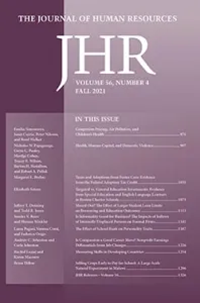谁从免费健康保险中受益?
IF 6
1区 经济学
Q1 ECONOMICS
引用次数: 0
摘要
摘要:我们对墨西哥引入和扩大大型非合作医疗保险计划Seguro Popular(SP)对健康的影响进行了全面评估,该计划为没有社会保障的个人提供了无需共同支付费用的医疗服务。我们通过在2002年至2010年期间在各城市的推广来确定该计划的影响。一般来说,我们没有发现对死亡率的显著影响(总体或任何年龄);唯一的例外是贫困城市的婴儿死亡率下降,对这些城市的意向治疗估计显示,由于SP,婴儿死亡率下降了10%。这一下降归因于与围产期疾病、先天畸形、腹泻和呼吸道感染相关的死亡人数减少。在这些贫困城市,SP使产科相关住院人数增加了7%,婴儿住院人数增加6%。富裕城市的死亡率或医院使用率没有受到影响。SP导致的婴儿死亡率下降几乎缩小了贫穷和富裕城市之间的所有婴儿死亡率差距。本文章由计算机程序翻译,如有差异,请以英文原文为准。
Who Benefits from Free Health Insurance?
ABSTRACT We present a comprehensive evaluation of the health impacts of the introduction and expansion of a large noncontributory health insurance program in Mexico, the Seguro Popular (SP), which provided access to health services without co-pays to individuals with no Social Security protection. We identify the program impacts using its rollout across municipalities between 2002 and 2010. In general, we do not detect significant effects on mortality (overall or at any age); the only exception is a reduction in infant mortality in poor municipalities for which intention- to-treat estimates show a 10 percent decline due to SP. This decline is attributable to reductions in deaths associated with conditions originating in the perinatal period, congenital malformations, diarrhea, and respiratory infections. In these poor municipalities, SP increased obstetric-related hospital admissions by 7 percent and hospital admissions among infants by 6 percent. There were no impacts on mortality or use of hospitals in rich municipalities. The decline in infant mortality rate caused by SP closed nearly all of the infant mortality rate gap between poor and rich municipalities.
求助全文
通过发布文献求助,成功后即可免费获取论文全文。
去求助
来源期刊

Journal of Human Resources
Multiple-
CiteScore
7.00
自引率
1.90%
发文量
53
期刊介绍:
The Journal of Human Resources is among the leading journals in empirical microeconomics. Intended for scholars, policy makers, and practitioners, each issue examines research in a variety of fields including labor economics, development economics, health economics, and the economics of education, discrimination, and retirement. Founded in 1965, the Journal of Human Resources features articles that make scientific contributions in research relevant to public policy practitioners.
 求助内容:
求助内容: 应助结果提醒方式:
应助结果提醒方式:


